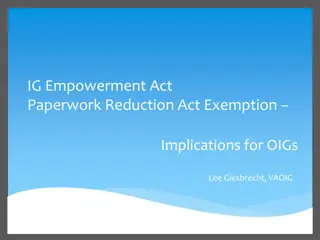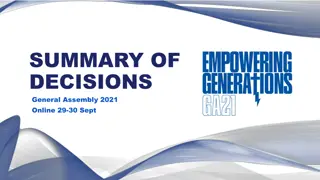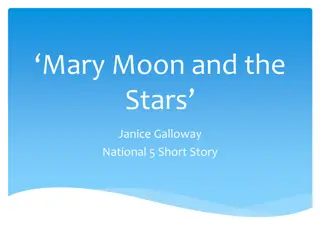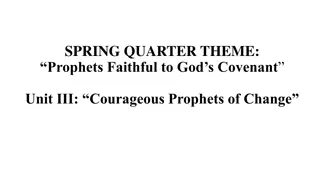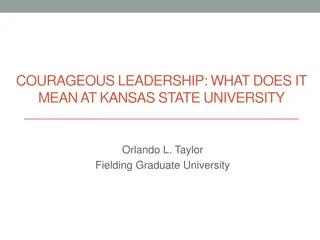Fearless by Janice Galloway: Analysis of a Courageous Act
Introduced to a mysterious character named Fearless, the story unfolds in a community where he is perceived as a tramp and frightening. Despite the societal pressure on women to tolerate his harassment, a young girl takes a stand by kicking him. The narrative explores themes of fear, courage, and societal norms through this pivotal act of defiance, leaving a lasting impact on the protagonist.
Download Presentation

Please find below an Image/Link to download the presentation.
The content on the website is provided AS IS for your information and personal use only. It may not be sold, licensed, or shared on other websites without obtaining consent from the author.If you encounter any issues during the download, it is possible that the publisher has removed the file from their server.
You are allowed to download the files provided on this website for personal or commercial use, subject to the condition that they are used lawfully. All files are the property of their respective owners.
The content on the website is provided AS IS for your information and personal use only. It may not be sold, licensed, or shared on other websites without obtaining consent from the author.
E N D
Presentation Transcript
Fearless By Janice Galloway
Pre-Reading What does the word Fearless make you think of? What do you think the story will be about?
In the exam you must be able to write a brief summary of your text. Plot In your group discuss they most important aspects of the story. Decide on 5 main plot points.
Plot Fearless general abuse in community The women s attitudes to Fearless The (lack of) reaction from the men. She kicks Fearless = turning point/climax. The outcome of her actions
Fearless Summary paragraph by paragraph 1. We are introduced to Fearless and what people do when they saw him. 2. Galloway gives us a description of Fearless. She goes onto tell us that people didn t look at him but still manages to convey that he is a mysterious character. 3. The villagers assumed he was a tramp and judged him for his living conditions. 4. Fearless behaves aggressively particularly to women. His name is used to frighten children. The men in the town think he is amusing and don t care about the fact that he harasses women. The women are scared of him and are under social pressure to accept the way they are treated by Fearless and the local men in general. 5. The paragraph described how she looked at Fearless and of how she feared him.
Fearless Summary paragraph by paragraph 6. The narrator and her mother were facing the window when Fearless was walking up the street. Fearless stopped and looked at them both. The young narrator was eventually so filled with rage she turned around and stared at him. 7. Unable to stop herself, she lashed out, kicking him in the shins.The young girl got a fright after kicking Fearless. Then was given into trouble for her actions. 8. It was a long time ago but she still hears the clink and drag sometimes. She also still hears her mother warning her about Fearless and the problems people like him cause.
Who is the protagonist? Who is the antagonist? Describe the character of Fearless. Check Understanding Describe the community in the story. What lessons did the adults teach children? What is the message of this short story?
Fearless When referring to the text Fearless we must use inverted commas. However, they are not needed when referring to the character of Fearless. Possessive form of Fearless is Fearless E.g. The actions of Fearless are despicable. Fearless actions are despicable.
Author vs. Character Galloway is the author but also the narrator of this story. Although this is a fiction text it is based on a time in Galloway s own childhood in 1950 s Glasgow When we refer to author we simply use Galloway When we refer to the character we use young Galloway . Exception: the final paragraph of the story is in present time and therefore Galloway is no longer a child.
Title The title is always important. Why is Fearless a good title for this story? Discuss in your groups.
3 meanings: Fearless= literally the name of the male character. Fear less = by the end, she has come to fear men less. TITLE (PUN) Fear less = as a child she lost her fear for a moment. Galloway clearly tells the reader that this was beyond her control. Every part of her being was rejecting this male oppression. And it still does..
Theme The theme is the big picture idea in a text. E.g. What the text is about. Discuss the themes we can see in Fearless .
Themes Gender Division Inequality Violence Alcoholism Misogyny (the hatred of women)
We will focus on gender inequality and issues surrounding this. Using a highlighter find and highlight 10 quotes that you could associate with this.
Choose 3 of the quotesNow ANALYSE Even years later, nothing has changed. The words choice still highlighting it s a continuing problem and something suggesting that there are many men like Fearless. But I still hear something like him; the chink and drag from the close- mouth in the dark, coming across open, derelict spaces at night, blustering at bus stops where I have to wait alone The use of a list after the semi-colon indicating the many different places that a women should fear. Predators can lurk where it is dark or abandoned.
Gender divide may look at both sides. Galloway focuses on Fearless hatred of women by describing an atrocious character for whom we have nothing but dislike. By immersing the reader in young Galloway s hatred (through first person narration and through her use of personal pronoun you ) we identify with the point she is making. THEMES
The setting is extremely important because the experiences the characters have are closely shaped by the immediate environment that they find themselves exposed to. In your groups discuss the setting of the story. Setting Think about the wider setting as well as the more obvious settings. How do you know what the setting is? (i.e. quotes)
SETTING Fearless suggests the importance of place in its relation to identity. 1950s West of Scotland (Saltcoats) Male-dominated and misogynistic society where women were almost second-class citizens; looked down upon. Many of the themes in the story are associated with Scotland during this era. volatile maleness of the whole west coast legend (p.25)
Characterisation of Fearless Some ways to explore a character:
Characterisation of Fearless Some ways to explore a character: Speech Thoughts Effect on Others Actions Looks
How can we use this to examine the character of Fearless? S A T L E
1. In paragraph two we are given a thorough description of the character of Fearless. Comment upon the effectiveness of Galloway s language in this paragraph. Use at least two examples. 2. Galloway is quick to point out that Fearless wasn t a tramp in paragraph three. Outline the reasons for her opinion. Characterisation 3. Choose three words or phrases from page 24 that show how domineering Fearless was considered. Explain your choice. 4. Galloway compares Fearless to other characters on pages 24 & 25. Why are these comparisons effective?
NARRATIVE STANCE Narrative stance is the viewpoint from which we are told the story. Think about the point of view of narrator in this story. In your groups discuss why this might be important. Try to link the narrative stance back to the themes of the story.
Internal narration First person NARRRATIVE STANCE Female perspective Child s perspective
In your groups, identify each tense and explain why it has been used. Galloway uses more than one tense in Fearless .
TENSE: PAST AND PRESENT First person narrative, mostly re-telling of childhood event therefore past tense: when I was wee She changes in the middle to bring story to present day It was a long time ago. Galloway changes her tense to show that she STILL has hatred for men; still believes men feel they are superior to women.
Social Conditioning Social conditioning refers to the process of training individuals in a society to behave in a manner approved by the society in general. In your your groups discuss the social conditioning that occurs in this story.
People are expected to behave in a certain way in Fearless company. Fearless teaches the people in society how to behave. He does this through his abusive actions if they do not behave in the correct way. SOCIAL CONDITIONING The other adults in society teach the children, especially girls, to fear Fearless. They do this by behaving the correct way themselves and using Fearless as a threatening image.
Allegory and Symbolism Symbolism - The use of a symbols (concrete objects) to represent an abstract idea or emotion. E.G. A red rose symbolises love. Allegory A story which uses many interconnected symbols in such as way that in nearly every element of the narrative has a meaning beyond the literal level.
Fearless is a symbol for men of this time, and to a lesser extent, men of present day. We know this because she calls Fearless behaviour it throughout. This use of the plural pronoun helps to make the reader aware that Galloway is not simply referring to one person, but that this is a universal experience. SYMBOLISM in Fearless The narrator herself, therefore, becomes symbolic of women and she gives the message that women should not give in, submit, but should kick like a mule .
The allegorical story, can be read either literally or as a symbolic statement. Literal story: Conflict between young Galloway and Fearless Allegory Allegory: Conflict between men and women




